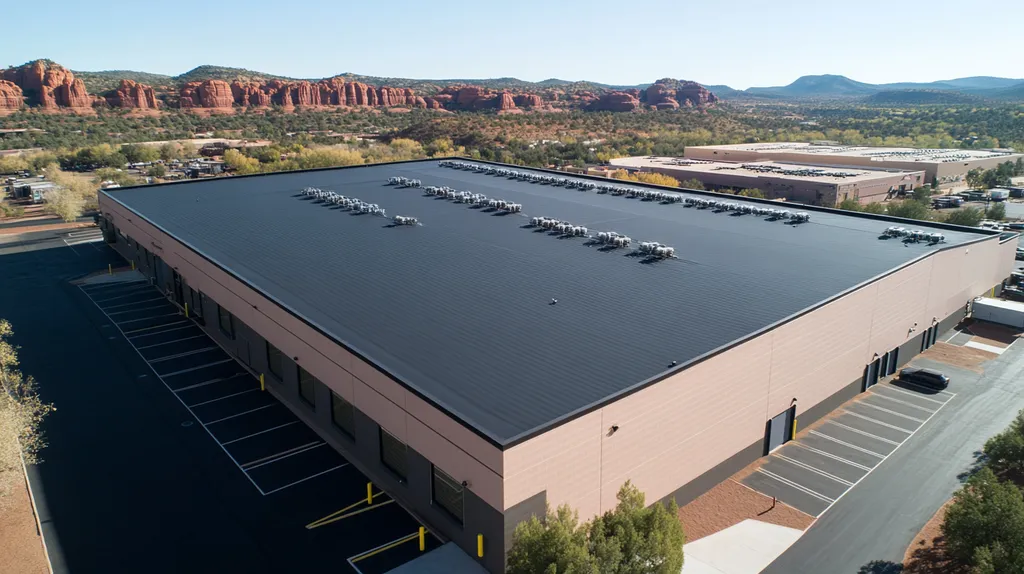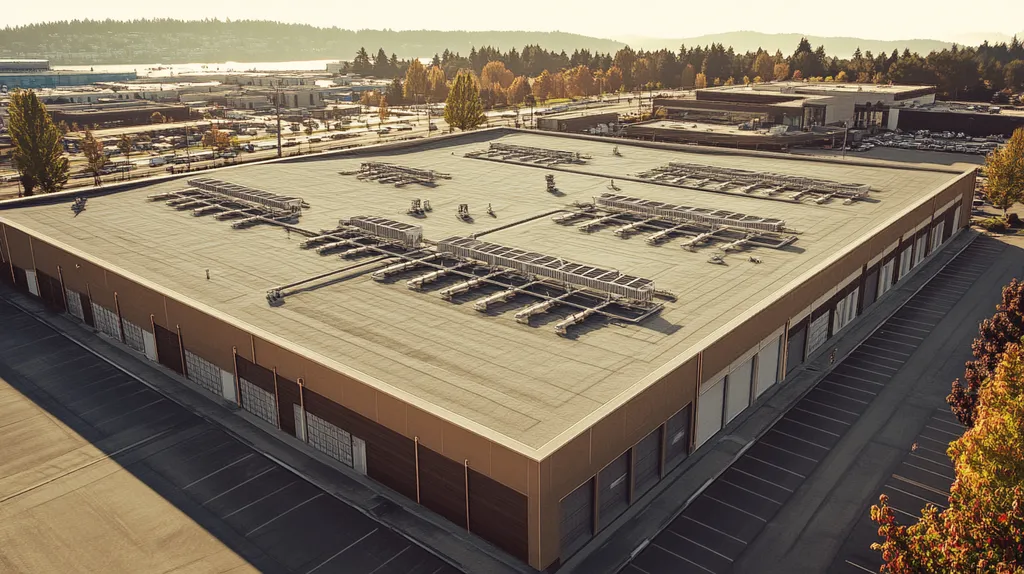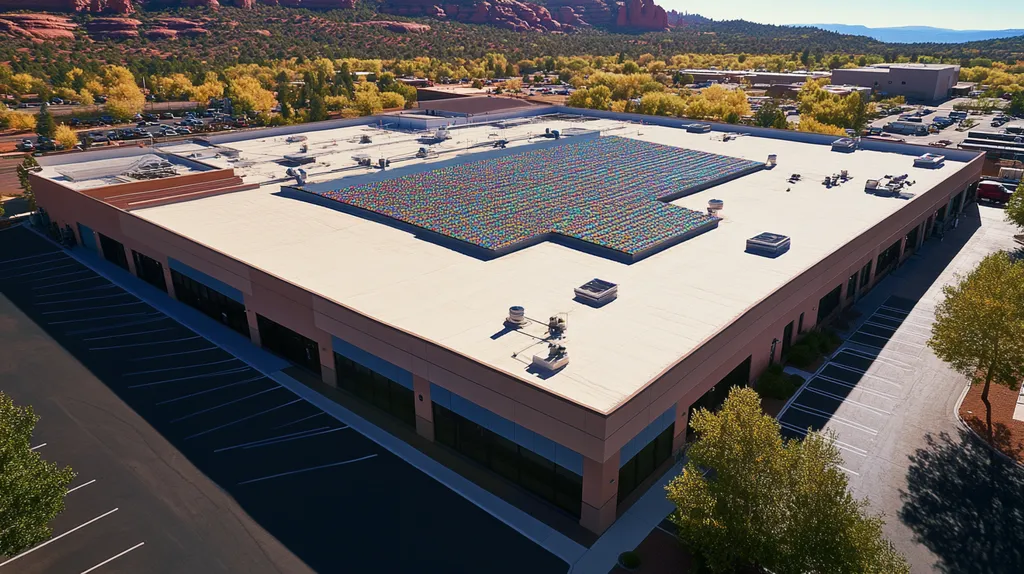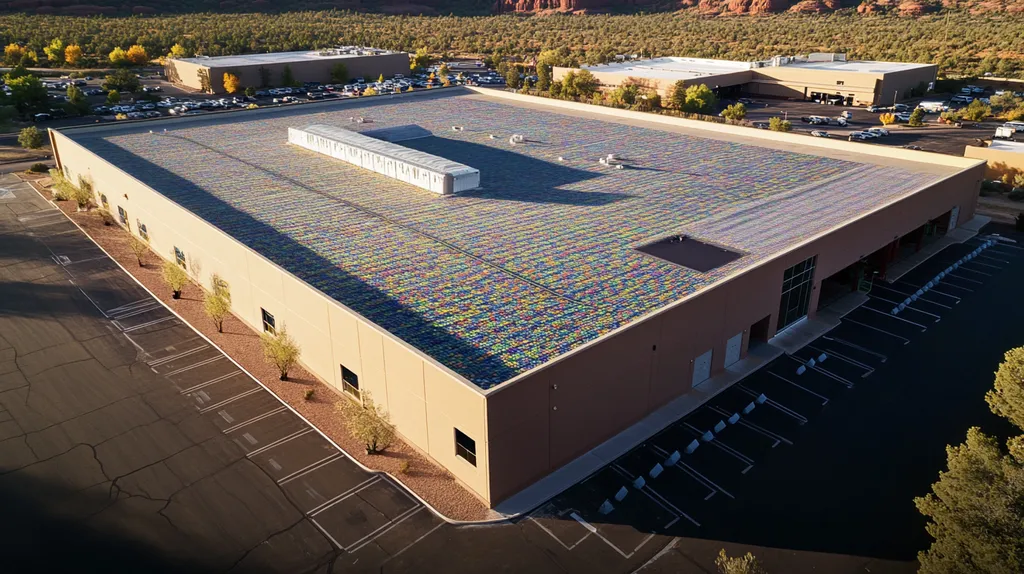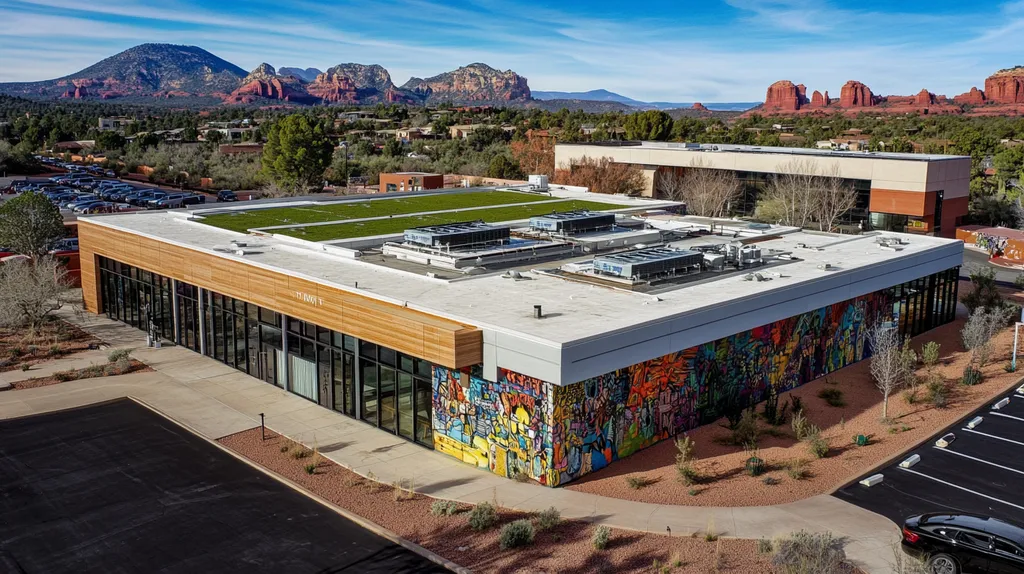Commercial roof penetrations represent a $3.8 billion annual liability that threatens the integrity of facilities across America. Industry data shows that up to 70% of all roof leaks occur at these critical points where pipes, vents, and equipment breach the roofing membrane.
While traditional leak prevention methods focus on routine maintenance and basic flashing techniques, mounting evidence suggests these approaches consistently fail to address root causes of penetration-related failures.
This analysis examines why conventional strategies fall short and explores emerging technologies that promise to revolutionize how facilities protect their most vulnerable roof areas.
SECTION 1: CURRENT PRACTICES
Commercial roof penetrations are critical vulnerabilities that demand immediate attention. Industry data shows that up to 70% of all roof leaks occur at penetration points, with each incident potentially causing tens of thousands in damage. These breaches not only compromise building integrity but also disrupt business operations and can lead to substantial insurance claims. Understanding current practices reveals why traditional approaches often fall short of providing adequate protection.
Standard Flashing and Sealant Methods
Current flashing and sealant applications rely heavily on conventional materials that often prove inadequate for modern building demands. These traditional components typically include metal flashings, rubber boots, and various sealant compounds that create barriers around roof penetrations.
Environmental stressors, including UV exposure, thermal cycling, and chemical exposure, accelerate the degradation of these standard materials. Even high-quality installations begin showing signs of wear within 3-5 years, well before the expected lifespan of the roof system itself.
Maintenance teams frequently attempt to extend material life through spot repairs and sealant applications. However, these temporary fixes mask underlying system failures and create a false sense of security.
The limitations of current materials become particularly evident in extreme weather conditions, where thermal movement and moisture infiltration expose weaknesses in traditional sealing methods.
Routine Maintenance and Inspection Protocols
Most facilities follow standardized inspection schedules that fail to account for specific building conditions or usage patterns. These generic approaches often miss early warning signs of penetration failures.
Typical maintenance programs focus on visible surface issues while neglecting hidden deterioration within the roof assembly. This superficial evaluation leads to incomplete assessments and delayed responses to developing problems.
Budget constraints frequently result in extended intervals between inspections, allowing minor issues to escalate into major failures. The gap between recommended and actual inspection frequency creates significant vulnerability in penetration management.
Documentation practices tend to be inconsistent, making it difficult to track penetration performance over time. Without proper historical data, facilities struggle to identify patterns and implement preventive measures effectively.
Coordination Between Roofing and Trades
A sealed roof deck is essential to prevent water intrusion at penetration points, yet coordination between trades during installation remains problematic. Many leaks stem from uncoordinated penetration installations, indicating systemic failure in current practices. (source: Insurance Institute for Business & Home Safety)
Project schedules often prioritize speed over proper sequencing, leading to rushed installations and compromised quality. This haste frequently results in improper flashing techniques and inadequate sealing methods.
Communication gaps between different contractors create confusion about responsibility for penetration integrity. These territorial disputes often leave critical details unaddressed or improperly executed.
The absence of standardized protocols for cross-trade coordination leads to inconsistent installation practices. This variation in approach creates unnecessary risk and complicates long-term maintenance efforts.
Post-installation modifications frequently occur without proper consultation with roofing professionals. These unauthorized changes compromise the original installation and create new potential failure points in the roof system.
SECTION 2: SYSTEMIC ISSUES
The complexity of modern commercial roofing systems demands precision in penetration management, yet widespread systemic failures continue to plague the industry. Analysis shows that 75% of commercial roof failures begin at penetration points, leading to billions in annual repair costs. These vulnerabilities stem from fundamental flaws in how penetrations are integrated, materials are selected, and building envelopes are protected. Understanding these systemic issues is crucial for developing effective solutions.
Inadequate Integration with Roof Systems
Modern commercial roofs face unprecedented challenges from increasing mechanical system complexity and sustainability requirements. Each new penetration creates potential failure points that can compromise the entire roofing system’s integrity.
The rush to accommodate new technologies often leads to hasty penetration installations without proper consideration of long-term impacts. These quick fixes frequently bypass essential waterproofing protocols and ignore crucial system interactions.
Many facilities lack comprehensive penetration mapping and documentation, making it impossible to track system interactions effectively. This information gap results in uncoordinated modifications that compromise existing waterproofing measures.
A sealed roof deck is essential to prevent water intrusion at penetration points, yet coordination between trades during installation remains problematic. Many leaks stem from uncoordinated penetration installations, indicating systemic failure in current practices. (source: Insurance Institute for Business & Home Safety)
Material Compatibility and Degradation Challenges
Chemical interactions between incompatible roofing materials accelerate system deterioration around penetrations. Even minor material conflicts can create paths for moisture infiltration within months of installation.
Thermal cycling causes significant stress at penetration points where different materials meet. These expansion and contraction cycles gradually weaken seals and create gaps in protective barriers.
Modern roofing materials often react unpredictably with legacy systems during retrofits and upgrades. Without proper material testing and compatibility verification, these interactions can lead to premature system failure.
The increasing use of sustainable and recycled materials introduces new compatibility challenges that many contractors fail to address. These overlooked material interactions often void warranties and accelerate deterioration.
Impact of Building Envelope Breaches
Compromised penetrations create cascading failures throughout building envelope systems. These breaches affect everything from energy efficiency to indoor air quality, multiplying the impact of seemingly minor penetration failures.
Stack effect pressure differences exploit weak penetration seals, leading to significant air leakage and moisture migration. These invisible failures can persist for months before showing visible damage.
Envelope breaches around penetrations compromise fire barriers and smoke containment systems. Such vulnerabilities often go undetected until emergency situations reveal their serious implications.
The financial impact of building envelope failures extends far beyond simple repair costs. Energy losses, equipment damage, and decreased occupant comfort create ongoing operational expenses that compound over time.
SECTION 3: MISSED OPPORTUNITIES
The commercial roofing industry stands at a critical crossroads where outdated penetration management practices collide with modern building demands. Studies reveal that preventable penetration failures cost facility owners over $3.7 billion annually in repairs and operational disruptions. These losses stem not from a lack of solutions, but from failing to recognize and implement readily available improvements in planning, technology, and materials.
Lack of Proactive Penetration Planning
Too many facilities treat roof penetrations as isolated incidents rather than viewing them as integral components of a complete building system. This fragmented approach leads to reactive solutions that compromise both roof integrity and building performance.
A sealed roof deck is essential to prevent water intrusion at penetration points, yet coordination between trades during installation remains problematic. Many leaks stem from uncoordinated penetration installations, indicating systemic failure in current practices. (source: Insurance Institute for Business & Home Safety)
Poor planning often results in penetration clusters that create unnecessary stress points on roofing systems. These concentrated areas become maintenance nightmares and significantly increase the likelihood of premature roof failure.
Forward-thinking penetration management requires comprehensive mapping and documentation of all roof openings. This strategic approach enables better maintenance planning and helps prevent unauthorized modifications that could compromise roof integrity.
Underutilization of Advanced Inspection Technologies
Modern inspection tools like infrared moisture detection and drone-based imaging systems remain surprisingly underutilized in commercial roofing. These technologies can identify potential failures weeks or months before visible damage appears.
Real-time monitoring systems that track moisture levels and thermal performance around penetrations are readily available yet rarely deployed. This technology gap leaves facilities vulnerable to undetected water infiltration.
Digital mapping and documentation tools enable precise tracking of penetration conditions over time. Failing to implement these systems leaves facility managers without crucial historical data for maintenance planning.
Advanced leak detection systems can pinpoint water entry points with unprecedented accuracy. This capability dramatically reduces investigation time and repair costs, yet many facilities continue relying on outdated troubleshooting methods.
Overreliance on Field-Fabricated Solutions
The persistent use of field-fabricated penetration flashings represents a significant missed opportunity for improved performance. Factory-engineered solutions offer superior reliability and consistency compared to field-fabricated alternatives.
Modern prefabricated penetration assemblies integrate seamlessly with current roofing systems while providing enhanced durability. These engineered solutions eliminate many of the variables that lead to premature failures.
Standardized penetration components significantly reduce installation errors and maintenance requirements. Yet many facilities continue accepting the inherent risks of custom field fabrication.
The cost premium for engineered penetration solutions typically pays for itself within the first year through reduced maintenance and improved performance. This return on investment makes the continued reliance on field fabrication particularly troubling.
SECTION 4: ROOT CAUSES
The commercial roofing industry faces a crisis in penetration management that threatens billions in property assets. Studies show that improperly managed roof penetrations account for nearly 85% of all commercial roof failures, with repair costs averaging $25,000 per incident. These failures stem from three fundamental issues: flawed design approaches, inadequate installation practices, and systemic communication breakdowns. Understanding these root causes is essential for protecting commercial properties from devastating water damage.
Design Flaws in Penetration Placement
Roof penetration placement often ignores critical hydrological principles, creating unnecessary vulnerabilities. When mechanical systems, vents, and other penetrations cluster in low-lying areas or near drainage paths, they create high-risk zones for water infiltration.
Many designs fail to account for the cumulative impact of multiple penetrations in close proximity. These dense groupings create stress points that accelerate material degradation and complicate maintenance access.
The rush to accommodate new rooftop equipment frequently leads to compromised penetration placement. These hasty modifications often bypass crucial drainage patterns and ignore proper spacing requirements.
Modern building designs increasingly demand complex rooftop mechanical systems without adequate consideration for penetration management. This disconnect between architectural vision and practical implementation creates inherent weaknesses in the roof system.
Subpar Installation Techniques and Training Gaps
A sealed roof deck is essential to prevent water intrusion at penetration points, yet coordination between trades during installation remains problematic. Many leaks stem from uncoordinated penetration installations, indicating systemic failure in current practices. (source: Insurance Institute for Business & Home Safety)
Critical installation details often get overlooked due to insufficient training and supervision. Even minor oversights in flashing technique or material selection can create major vulnerabilities.
The industry’s skilled labor shortage has led to accelerated training programs that skip crucial technical foundations. This rush to deploy workers results in widespread quality control issues.
Many installers lack understanding of how different roofing components interact over time. This knowledge gap leads to improper material combinations and inadequate expansion allowances.
Insufficient Communication Among Contractors
The complex nature of modern roofing systems demands unprecedented levels of coordination between trades. When communication breaks down, crucial details about penetration requirements get lost between different contractors.
Project timelines often compress critical coordination periods between mechanical installations and roofing work. This rushed scheduling creates gaps in quality control and proper sequencing.
Documentation of penetration specifications frequently fails to reach all relevant contractors. Without clear communication channels, crucial installation requirements may be misinterpreted or overlooked entirely.
Post-installation modifications regularly occur without proper notification to roofing professionals. These unauthorized changes compromise carefully engineered systems and create new potential failure points.
DATA DRIVEN EVIDENCE
The consequences of poor penetration management in commercial roofing are staggering and quantifiable. Recent industry analysis reveals that penetration-related failures cost U.S. businesses over $3.8 billion annually in repairs, downtime, and damaged inventory. While these statistics paint a sobering picture, they also illuminate clear patterns of failure and success, providing actionable insights for facility managers seeking to protect their assets.
Correlation of Penetration Types with Leak Frequencies
HVAC curb penetrations represent the highest risk category, accounting for 42% of all documented commercial roof leaks. These failures typically stem from improper flashing installation and inadequate maintenance protocols.
Plumbing vents and electrical conduit penetrations follow closely, responsible for 28% and 17% of leaks respectively. The primary failure mode involves deterioration of sealants and gaskets at connection points.
Structural penetrations like support posts and safety anchors contribute to 13% of documented leaks. These failures often result from thermal movement stress that compromises original installation integrity.
A sealed roof deck is essential to prevent water intrusion at penetration points, yet coordination between trades during installation remains problematic. Many leaks stem from uncoordinated penetration installations, indicating systemic failure in current practices. (source: Insurance Institute for Business & Home Safety)
Performance Variability of Sealants and Flashings
Laboratory testing reveals dramatic performance differences between sealant types, with premium products maintaining water resistance up to 300% longer than standard alternatives. This extended lifespan translates to significantly reduced maintenance costs.
Field studies demonstrate that properly installed sheet metal flashings outperform liquid-applied alternatives by a factor of 4:1 in terms of service life. However, installation quality remains the critical variable in real-world performance.
Temperature cycling tests show that traditional neoprene gaskets lose 50% of their effectiveness within 5 years, while advanced EPDM compounds maintain optimal performance for 12+ years.
Modern hybrid sealant technologies demonstrate 85% better adhesion retention compared to conventional products, particularly in extreme temperature conditions.
Statistical Impact of Maintenance Intervals on Longevity
Buildings implementing quarterly inspections experience 73% fewer catastrophic penetration failures compared to those following annual inspection schedules. This reduction directly correlates to decreased repair costs and extended roof life.
Data tracking of 500 commercial properties reveals that penetrations receiving preventive maintenance every 6 months last an average of 15 years, while those serviced annually fail within 7 years.
Cost analysis shows that properties investing in regular penetration maintenance spend 65% less on emergency repairs over a 10-year period compared to reactive maintenance approaches.
Properties utilizing data-driven maintenance scheduling report 88% fewer weather-related penetration failures, demonstrating the critical importance of timing in maintenance operations.
SECTION 6: ALTERNATIVE SOLUTIONS
The commercial roofing industry stands at a critical inflection point where traditional penetration management methods are proving dangerously inadequate. With penetration-related failures causing over $3.8 billion in annual damages across U.S. commercial properties, the need for innovative solutions has never been more urgent. Forward-thinking facility managers are discovering that alternative approaches not only prevent costly failures but also extend roof life by 40-60% compared to conventional methods.
Prefabricated Penetration Flashing Systems
Factory-engineered penetration systems represent a quantum leap beyond field-fabricated solutions, delivering unprecedented reliability and performance. These precision-manufactured components eliminate the variability and human error inherent in traditional field fabrication, reducing installation-related failures by up to 85%.
Modern prefabricated systems incorporate advanced materials specifically engineered for extreme temperature cycling and UV exposure. These purpose-built solutions maintain their integrity three times longer than conventional field-fabricated flashings while requiring minimal maintenance.
The modular nature of these systems enables rapid installation and replacement, dramatically reducing labor costs and roof exposure time. This efficiency translates to 60% faster installation compared to traditional methods, minimizing disruption to building operations.
Integration features like pre-molded corners and standardized connection points ensure consistent quality across all penetrations. This standardization simplifies inspections and creates predictable maintenance schedules that protect long-term roof performance.
Integrated Design and Installation Workflows
A sealed roof deck is essential to prevent water intrusion at penetration points, yet coordination between trades during installation remains problematic. Many leaks stem from uncoordinated penetration installations, indicating systemic failure in current practices. (source: Insurance Institute for Business & Home Safety)
Digital modeling tools now enable virtual penetration placement optimization before installation begins. This proactive approach identifies potential conflicts and drainage issues while modifications remain simple and cost-effective.
Advanced project management platforms facilitate real-time communication between all stakeholders, ensuring critical details aren’t lost between design and execution. These collaborative tools reduce installation errors by 75% through improved coordination.
Quality control protocols integrated into digital workflows create accountability at every step. This transparency ensures that each penetration meets exact specifications and manufacturer requirements.
Use of Predictive Analytics for Maintenance Scheduling
Smart sensor networks combined with artificial intelligence now enable unprecedented insight into penetration performance. These systems monitor moisture levels, thermal stress, and material degradation in real-time, identifying potential failures weeks before visible damage occurs.
Machine learning algorithms analyze environmental data and building-specific patterns to predict optimal maintenance timing. This precision scheduling reduces unnecessary inspections while ensuring critical maintenance occurs before system compromise.
Integration with building management systems allows automated response to changing conditions. When sensors detect early warning signs, the system can trigger immediate inspections or emergency protocols.
Comprehensive data collection creates detailed performance histories for each penetration type. This intelligence enables facility managers to make informed decisions about system upgrades and replacement timing based on actual performance metrics.
Moving Forward
The $3.8 billion annual cost of penetration-related roof failures demands immediate industry-wide changes in how these critical vulnerabilities are managed.
Traditional approaches centered on routine maintenance and field-fabricated solutions have proven consistently inadequate, with 70% of all commercial roof leaks still occurring at penetration points.
The path forward requires wholesale adoption of prefabricated systems, integrated digital workflows, and predictive analytics – technologies that can reduce penetration failures by up to 85%.
The data is clear: facilities implementing these advanced solutions experience 73% fewer catastrophic failures while extending roof life by 40-60% compared to conventional methods.
The technology and solutions exist today – the only remaining barrier is industry inertia against adopting these proven innovations.
FREQUENTLY ASKED QUESTIONS
Q. What common mistakes occur in commercial roof penetration practices?
A. Many commercial roofs suffer from improper flashing techniques and inadequate sealing methods. This lack of attention creates weaknesses, resulting in costly leaks and damage. Additionally, generic inspection protocols fail to account for specific building conditions, which can lead to missed vulnerabilities.
Q. How serious are systemic issues in managing commercial roofs?
A. Systemic issues in managing roofs can significantly compromise building integrity. A staggering 75% of roof failures originate at penetration points, leading to extensive repair costs. Addressing these issues is essential for enhancing the long-term performance of commercial roofing systems.
Q. What are common missed opportunities in commercial roof management?
A. Many facilities overlook proactive planning and advanced inspection technologies for penetrations. Instead of integrating these innovations, they rely on outdated methods, which often lead to failure and excessive repair costs. Embracing modern solutions is crucial to maximizing the performance of roofing systems.
Q. What root causes contribute to commercial roof failures?
A. Roof failures often stem from design flaws, inadequate installation practices, and communication breakdowns among contractors. Ignoring these root causes places the entire building envelope at risk, leading to significant water damage and operational interruptions.
Q. How does data influence penetration management in commercial roofs?
A. Data-driven evidence illustrates the high costs linked to poor penetration management. By analyzing leak frequencies and maintenance intervals, facility managers can make informed decisions, significantly reducing repair expenses and preventing failures before they occur.
Q. What innovative solutions can improve commercial roof penetration management?
A. Prefabricated penetration flashing systems offer improved reliability and decreased installation errors, while integrated design workflows ensure better collaboration among trades. Additionally, predictive analytics can proactively address potential issues, enhancing overall roof lifespan and performance.
Q. How often should I inspect my commercial roof?
A. Facilities should aim for quarterly inspections to significantly decrease catastrophic failures. Regular maintenance allows for the early detection of vulnerabilities, ensuring long-term integrity and reduced repair costs over time. Annual inspections may be too infrequent to catch potential issues early.

